Affiliate disclosure: This post may contain affiliate links. Please see our Privacy Policy.
Pineapple wine is a sweet tropical treat that’s perfect for summertime sipping. It takes a few months of patience to make fresh pineapple wine, but it’s worth the wait!
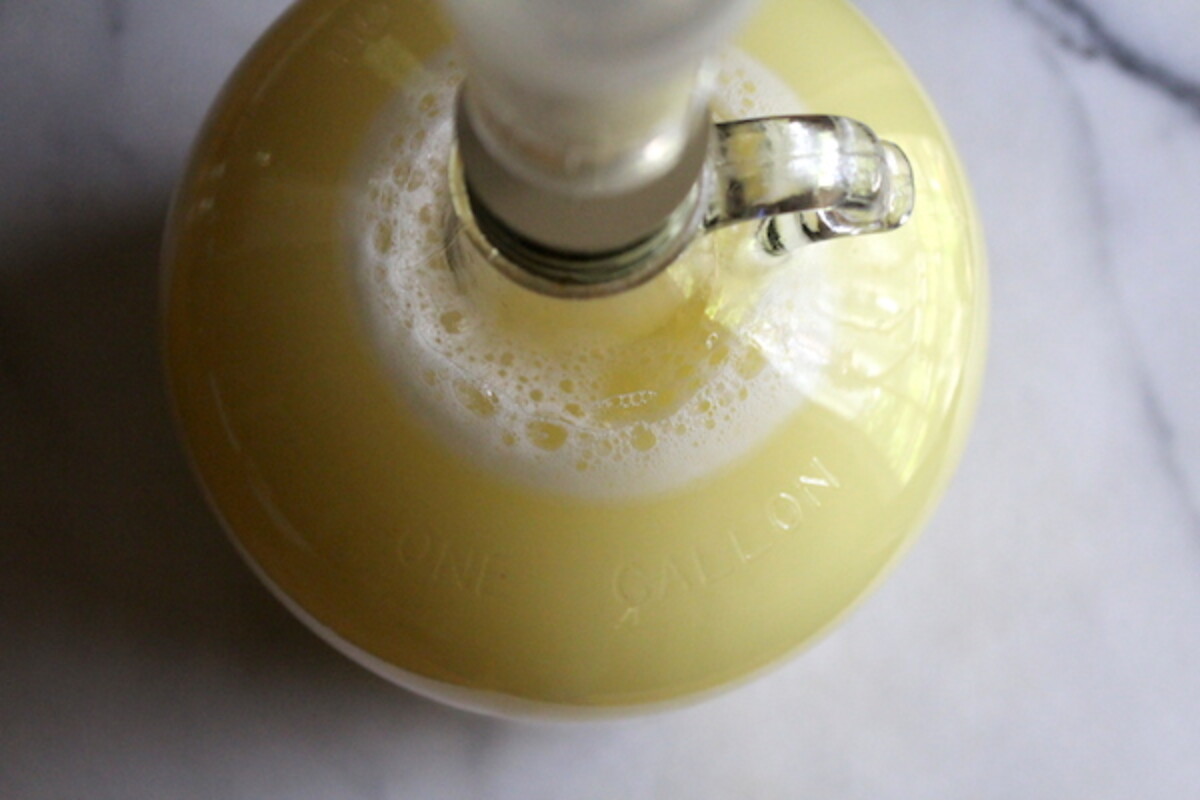
If you’re not familiar with winemaking, I’d suggest reading this beginner’s guide to small batch wine before beginning. This recipe can also be made as a pineapple mead, by substituting honey for the sugar in the recipe. Here’s a tutorial on how to make mead of all kinds.
Pineapple Wine Recipes
I have at least a dozen winemaking books and I consulted them all to come up with this recipe for pineapple wine. It’s closest to the Hawaiian Pineapple Wine Recipe from The Joy of Home Winemaking by Terry Garey.
Most of the recipes were pretty similar, recommending that you start with fresh pineapple (instead of canned juice). Canned juice has a “tinned” taste that’s noticeable in the finished wine, and it’s pretty unappealing. If you must use juice, opt for pineapple juice that’s bottled in glass or plastic instead.
Langers has 100% pineapple juice bottled in plastic, and Lakewood organics has a version bottled in glass.
Sometimes all you’ll be able to find is a pineapple juice blend, and that’s fine too. Just be sure it doesn’t contain any preservatives (which will prevent fermentation).
For a pineapple wine made with juice, substitute 2 quarts of pineapple juice in place of the fresh pineapple (and fill with water).
At the very end, I’ll also walk you through a recipe for a low input pineapple wine made without winemaking chemicals, if you’re trying to make it quickly with just what you have in your kitchen. First though, here’s a basic pineapple wine recipe that follows the traditional route including winemaking additives to ensure a consistent result.
Ingredients for Fresh Pineapple Wine
Note that the pineapple here is weighed after chopping, so you’ll need 5 to 6 pounds of whole pineapple. They vary considerably in size, but that’s about 2 to 3 pineapples.
- 3 to 4 pounds pineapple (7 to 10 cups, chopped)
- 2 lbs sugar (or 2 lbs honey for pineapple mead)
- 1/2 tsp. Acid Blend
- 1/4 tsp. Wine Tannin
- 1 tsp. Yeast Nutrient
- 1/2 tsp. Pectic Enzyme (optional, but recommended)
- 1 Campden tablet, crushed (optional)
- 1 packet wine yeast
How to Make Pineapple Wine
Prepare the pineapple by removing the skin and top, then chopping it into small pieces. Do your best to reserve any juice that flows out during chopping. Place the chopped pineapple in a nylon brewing bag at the bottom of a primary fermentation bucket.
All my nylon bags were in use dry hopping homemade beer, and I was fresh out of brewing buckets too. I just opted to use my wide mouth glass jar fermenter jar, which is a little small for the task. Ideally, your primary fermenter would be at least 2 gallons to accommodate a vigorous fermentation.
I used 3 pineapples average-sized pineapples, which would have yielded around 10 cups…but I included the pineapple cores. Most of the recipes have you remove those, but that’s not really necessary.
I use the cores as a source of juice when I’m canning pineapple, and I know they taste great. They’re tough and fibrous but have great flavor and they’ll be filtered out of the finished wine so the texture isn’t really an issue.
It mostly filled the 1-gallon wide mouth carboy.
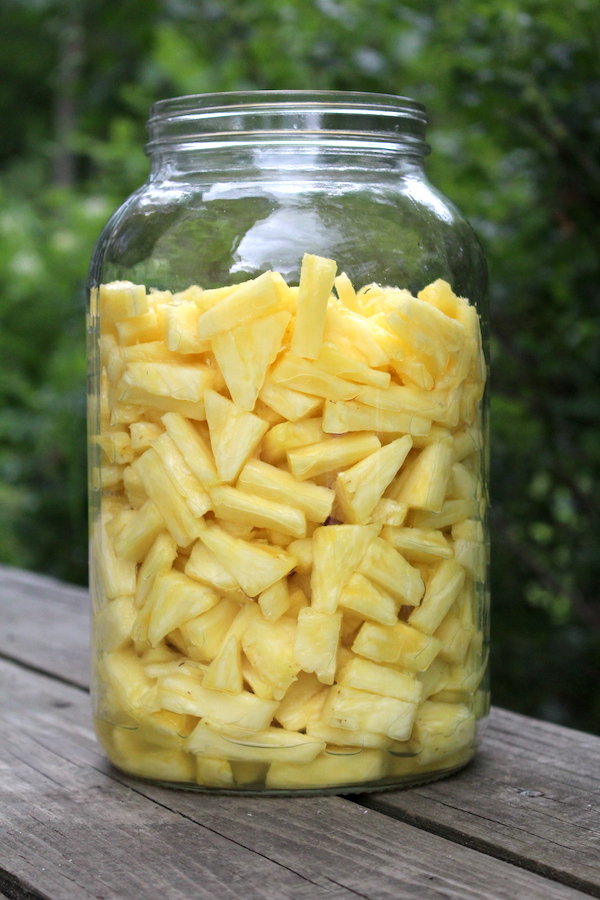
Next, fill a pot with about 3 quarts of water and bring it to a boil on the stove. Add the sugar and stir to dissolve, then remove from heat.
Allow the mixture to cool, then pour it over the chopped pineapple in the primary fermenter.
Add the remaining ingredients except the yeast, including yeast nutrient, tannin, acid, and the crushed Camden tablet (if using). The Camden tablet is used to sterilize the ingredients, though it won’t kill everything or make up for bad sanitation. It’s basically to beat back anything that may already be living in the pineapple so the yeast can take hold first.
If you’re using a Camden tablet, allow the mixture to sit for 24 hours before adding the yeast. (If not using a Camden tablet, then simply wait until everything’s cooled to room temperature before adding the yeast.)
Cover the fermenter with a towel or loosely with a lid, but don’t put on a water lock yet. The yeast should begin vigorously fermenting within 24 to 48 hours, and a water lock would just get clogged and messy at this point.
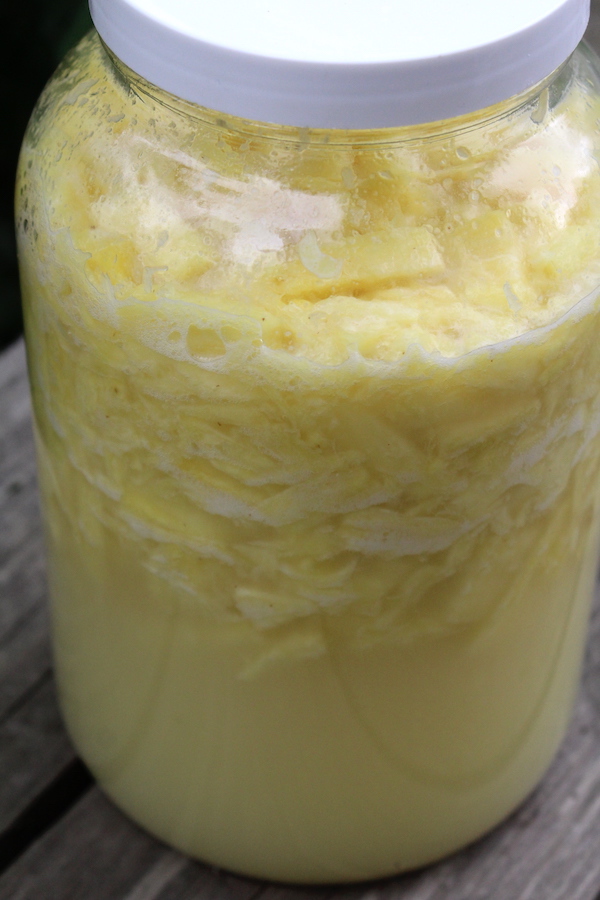
Allow the pineapple wine to ferment in primary for about a week to 10 days. After that, remove the pineapple, either by lifting the nylon bag or filtering everything through a fine-mesh strainer.
Siphon the strained mixture to a narrow neck glass carboy, leaving any sediment behind. Fill to within a few inches of the top with clean unchlorinated water and cap with a water lock.
At this point, the fermentation should still be going pretty strong, especially invigorated by all the added oxygen as it’s moved from primary to secondary.
Allow the mixture to ferment in secondary for at least 6 to 8 weeks.
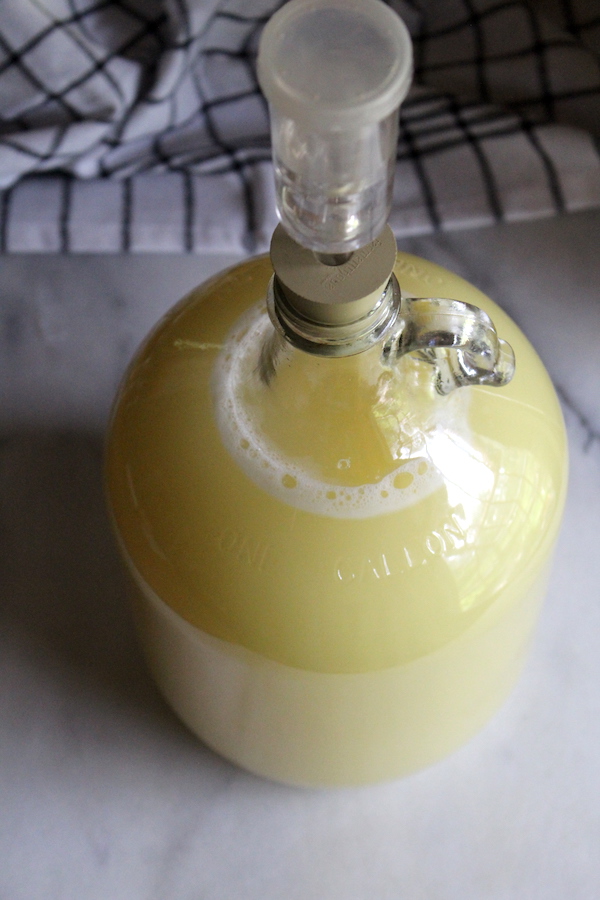
Pineapple wine tends to be cloudy, which is one reason the pectic enzyme is used to help break down the cells of the fruit and clarify the wine. Still, it’ll likely need to be racked several times to help it clear.
Rack the wine after 2 months in secondary, then again at 4 months. At 6 months, either bottle or rack one final time.
Bottling Pineapple Wine
At bottling time, taste the pineapple wine. If it’s sweet enough for your liking, feel free to just bottle it as is. (That’s what I did, but I don’t like my wine overly sweet.)
Most of my winemaking guides suggest stabilizing at bottling time and then adding 2 to 4 ounces of sugar dissolved in a bit of water. This back sweetening will help bring out the tropical flavors, and obviously sweeten the finished wine.
You’ll need additional winemaking additives if you choose to stabilize the wine and back sweeten, and you can find detailed instructions on stabilizing wines here.
Allow the pineapple wine to bottle condition for at least 2 months, preferably longer, before drinking.

Pineapple Wine
Ingredients
- 3 to 4 lbs pineapple, 7 to 10 cups, chopped *See Note if using juice
- 2 lbs sugar, or 2 lbs honey for pineapple mead
- 1/2 tsp. Acid Blend
- 1/4 tsp. tannin powder
- 1 tsp. Yeast Nutrient
- 1/2 tsp. Pectic Enzyme, optional, but recommended
- 1 Campden tablet, crushed (optional)
- 1 wine yeast
Instructions
- Peel and chop pineapple and place it in a nylon fermentation bag inside a bucket fermenter (at least 2 gallons in size).
- Bring 3 quarts water and sugar to a boil on the stove, stir to dissolve, and then remove from heat.
- Allow the sugar water to cool to room temperature, then pour it over the pineapple in the fermenter.
- Add the remaining ingredients (except yeast), including tannin, acid, yeast nutrient, and crushed Camden tablet (if using). Stir to incorporate.
- Allow the mixture to sit covered with a towel for 24 hours to allow the Camden tablet to work (skip this waiting period if not using Camden tablet).
- After 24 hours, add the yeast and recover with a towel or cover loosely with a lid. The mixture will be vigorously fermenting, so it’s not necessary (or recommended) to use a water lock during this stage.
- Allow the mixture to ferment in primary for 7 to 10 days, until the vigorous fermentation slows. Remove the pineapple and siphon into a secondary fermenter, filling to within a few inches of the top with unchlorinated water. (A one-gallon narrow neck glass carboy is recommended.) Cap with a water lock and allow the mixture to ferment for 6 to 8 weeks.
- At this point, the wine could be bottled, but it’s highly recommended to rack several more times to help mature and clarify the wine. I’d suggest racking every 2 months for a total of 6 months (after the primary) before bottling.
- At bottling time, you can choose to bottle the wine as it is (as I did), or stabilize the wine and back sweeten with 2 to 6 ounces of sugar dissolved in water. Taste the wine before you bottle and make the decision based on your palate (adding sugar for a sweeter wine).
- Allow the wine to bottle condition for at least 2 months before drinking (preferably longer).
Notes
Nutrition
Nutrition information is automatically calculated, so should only be used as an approximation.
No Additive Pineapple Wine with Juice
This recipe comes from Artisanal Small Batch Brewing written by my friend Amber Shehan.
She avoids using winemaking chemicals in her recipes (tannin, yeast nutrient, etc) and instead uses natural things you’d otherwise already have in your kitchen like black tea and raisins.
I really love her book, and the “low input” approach to making wine, mead, and beer. I’ve made many of her recipes and they always turn out spectacular. (Check out her recipe for lemon balm mead, it’s a winner!)
This is an easy way to make pineapple wine without spending a lot of money on specialty ingredients:
- 2 quarts pineapple juice
- 1 lb sugar
- 1/8 cup raisins, chopped
- 1 cup strongly brewed black tea
- 1 packet Lavin K1-V116 Wine Yeast
- Water to fill
- 1 cup simple syrup (for secondary)
She starts by having you warm everything (except the yeast) to dissolve the sugar, then allows it to cool completely. It’s then poured into a carboy, filled to within 2 inches of the top with water and the yeast is pitched.
It’s then fermented in primary for 10-14 days (with a water lock, or just covered with a towel). She notes that if you do use a water lock, you’ll need to clean it frequently as this is a vigorous fermenter.
After fermentation slows down, she racks it over into a clean carboy onto 1 cup of simple syrup. (Made from 1 cup sugar and 1 cup water, boiled the cooled completely.) Cap with a water lock and allow to ferment to completion (roughly 6 to 8 weeks at room temperature or slightly cooler).
Fruit Wine Recipes
Looking for more fruit wine recipes? Read on…
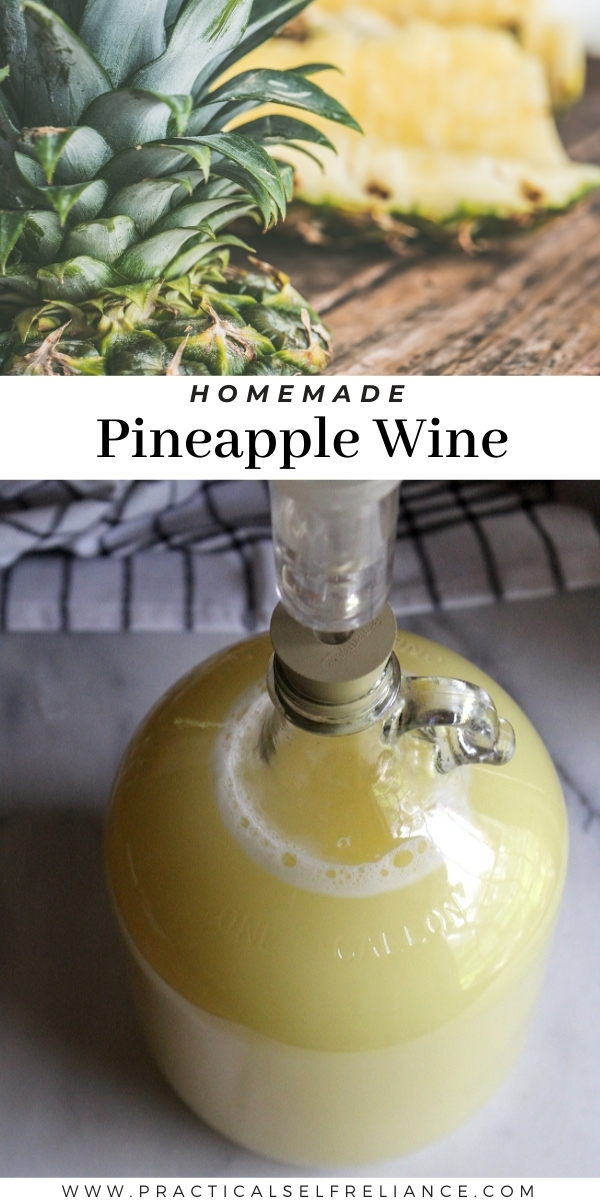



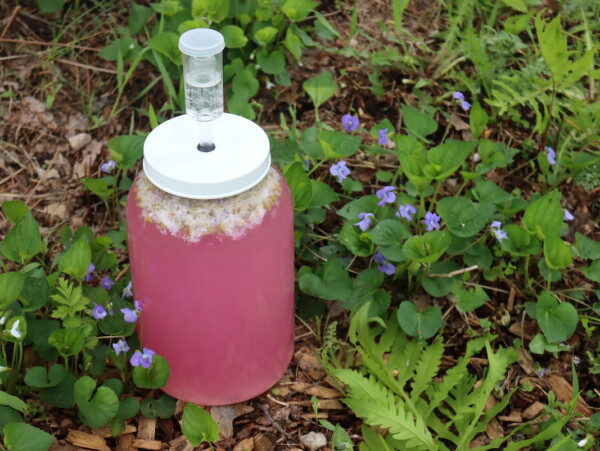










Hi, I am currently racking my lemon wine that I got from you and im very excited to get to a finishing point. In the meantime time, I was looking this recipe and wondering if you would have recommendations on how to mix ypjr pineapple recipe with your cranberry recipe? I love those flavors together and think it would be amazing but im.sos new to this im afraid to try to customize a recipe. I’d be interested in your thoughts. Thanks for these amazing recipes!
That sounds amazing. If I were going to do it, I’d just make a half batch of each recipe together in the same container. Let me know how it goes for you!
It would be handy to know how much wine and how much water went into the car boy at 2nd fermentation. I’m in Australia and don’t use gallons so I am constantly converting. We don’t have gallons so can’t just fill to near the top. Any idea, even the percentages of wine to water so I can estimate.
You don’t actually have to add any water to it. The more water you add, the more diluted the flavor will be. The additional water is only added to eliminate too much extra oxygen inside the fermentation vessel. I would just look for a fermentation vessel that will hold your liquid without much room left at the top. You can add a little water if needed but you want to only add enough so that your container is nearly full.
I love wine, and pineapple wine is one of my favorites! It’s sweet and fruity, and perfect for a summer evening.
Why not include the rind of the pineapple? Does it affect the finished taste or do it contain unwanted natural yeast? I grow them and I’ve getting ready to harvest a few and was curious?
I would imagine that the flavor wouldn’t be as good with the rind included.
HI there! I am just starting out with wine making. So far a lot of research and I finally started buying the supplies I will need for wine making. I am most intrigued by your pineapple wine and cranberry wine recipe. I was wondering but have found little information on this. What are your thoughts about making a cranberry/pineapple wine? Is there anything you think could prevent this from working or any tips you have that might help me in my venture?
That sounds delicious, and I think it’d work out wonderfully! I’d honestly just combine the recipes using half of the ingredients required for each and I think it’d be great. Best of luck!
This sounds wonderful!
Transferred my batch to my carboy but have not noticed much activity going on. Should I continue with the fermentation or toss it out and start over.
How long had it been fermenting when you transferred it?
Hello. It was fermenting for ten days.
And how long has it been in the secondary now and what does the activity look like?
It has been in a carboy with airlock for about a week. There is no visible activity.
Did you use non-chlorinated water? And was it very active when you transferred it over?
Yes I used non chlorinated water but it was not active when I transferred it over.
At this point, I don’t think it would hurt to go ahead and let it do it’s thing and see what happens. Just keep an eye on it and let me know if there are any changes.
Hello again. Well I racked my wine today for the first time. It is very cloudy. Also had a taste. Definitely has an acidic bite to it. Should I dump it and start over?
It’s actually not unusual for pineapple wine to be cloudy and you will actually want to rack it several times to help it clarify. You want to rack it after 2 months into the secondary, then again at 4 months and at 6 months either rack it again or bottle. When you get ready to bottle it you can stabilize it and back sweeten if it isn’t sweet enough for you. Then you want to let it condition for at least 2 months but preferably longer after bottling before drinking.
You are the best ever ❤
I want to make 5 gallons, how may pounds of hole pinapple would you recomend?
Doin this in a 6.5 gallon big mouth bubbler.
Also would you do a 24 hour freeze after you chop the pinapple to break down the cell walls and maximize the pinapple chunks
If you want to make 5 gallons, you can simply multiply the recipe by 5. Many people suggest freezing fruit prior to making wine. If you try it out, let us know how it works for you.
I made this. It turned out pretty good but I with it had more pineapple flavor.
I used 10 pineapples and made 3 gallons of wine.
Can’t wait this sounds very unique tasting. I love pineapples!